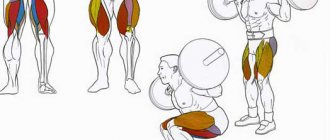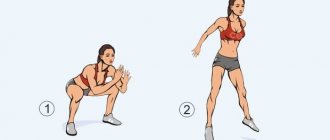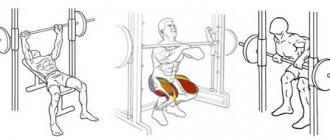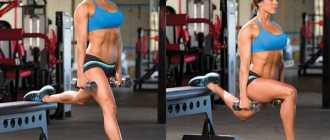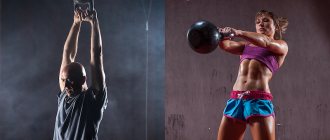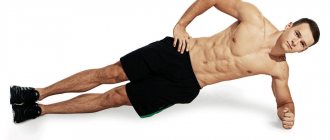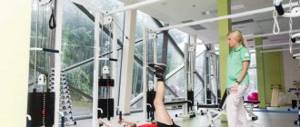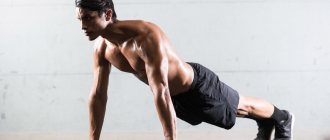Now about the technology.
You can see many techniques and variations of squats. So which option should you choose? The most important requirement is that you should be comfortable, comfortable and stable during squats. Squatting itself is absolutely natural for the musculoskeletal system. Moreover, squatting is the most natural, archaic way of sitting.
And physiologists claim that, in terms of their strength properties, all structures and surfaces of the knee joint correspond to the maximum flexion of the knee joint.
But don’t rush to recommend deep sed to clients
Please note that the people in these photos, firstly, are accustomed to this way of sitting, their muscles are elastic and their joints are mobile, and secondly, they do not have a barbell on their shoulders
Let's look inside the knee joint again. What structures are subject to mechanical stress when it is bent?
Firstly, it is the cartilage that covers the femur and tibia. Secondly, these are the menisci. Thirdly, cartilage on the inside of the patella and femur.
Squats at home: simplicity and convenience
You have several reasons to systematically do this exercise without leaving home:
- You don't need any special equipment to do squats. It’s great if you have dumbbells - you can use them for weights during the exercise;
- you don’t need a lot of space for squats;
- one simple exercise makes the muscles of the buttocks and thighs work, tightens the abs and back, removes the sides from the waist;
- the correct technique for doing squats is very easy to master;
- You don’t have to be afraid that the exercise will get boring after a while - it has a lot of options, one more effective than the other.
MirSovetov hastens to warn you that you should not count on quick results from the exercise. In order to lose weight by doing squats, it will take a lot of time, so impulsive and impatient people are better off finding another way to lose weight. However, those whose character allows them to squat every day for a long time speak flatteringly about the exercise.
Men VS Women
Well, how can you still squat if it’s good this way and that, and it’s possible this way and that?
For girls
- We sit down as deep as possible, by moving the pelvis back, and not by bending the knees.
- Your knees do not go beyond your toes, and in order to squat as low as possible in this position, you need to tilt your body forward. BUT your back is always straight!!! It is allowed to tilt up to 45 degrees, but I wouldn’t go further than 30, try to keep your back as straight as possible, and bend only to pull your buttocks back if necessary. The more vertical your back is, the more your knees will move forward and vice versa, the stronger the back tilt, the closer your shins are to the vertical, i.e. less acute angle.
- Your main focus is on the glutes and lower thigh stretches. Only the pelvic-dominant style is suitable for you, when the knees are fixed and the pelvis rotates around them.
- Weight is practically irrelevant. Only the force of tension and stretching of the muscles.
Women's version of squats:
For boys
- We sit down to the CORRECT parallel. Knees and upper thighs in one line.
- We keep our back as vertical as possible, this creates maximum load on the front surface of the thigh. Which style you choose is your decision.
Men's version of squats:
How do I do it? Like a half-girl... I squat as low as the stretch allows, with the pelvis abducted, but I keep my body vertical, this is a lifter's style.
Causes:
1. I don’t have time, like professionals, to divide workouts into different muscle groups, so I try to cover as much as possible. The lower the squat, the more muscles are worked, which allows me to avoid focusing on the hamstrings.
2. Knees!!! I knocked out my wrists in boxing, injured my elbows in arm wrestling, my knees have been working in harsh conditions for 17 years now, and no problems, although for many they begin to “crunch” even without load. This is because in modern life there is no load on the biceps and adductors, this creates an imbalance and subsequent problems.
And one more small note. What is the most UNSTABLE position of the knee joint? When the angle is 90 degrees. That's why honey. examinations, you are asked to sit in a chair before your knee is examined, i.e. he is diagnosed in his most vulnerable state.
If you squat TO PARALLEL, then the knee angle will be 90 degrees, you take more weight than for a deep squat, which means the load on the knee is greater and the biceps muscles of the back surface do not balance the squat. We get the fastest way to twist our knees like a grasshopper!
3. Back injuries - the smaller the amplitude, the more weight we can lift. I am interested in maximum body development, not in records, so my modest 150 kg will always be the upper limit for me.
4. There is no problem getting a fat butt from deep squats, because... it depends on the amount of fat in the body, so whether men should be afraid of this or not, everyone decides individually:
Is it possible to pump up your buttocks with squats?
Squatting is rightfully the most effective method for creating firm, rounded buttocks. Muscles lend themselves well to pumping, but for visible results you need hard training and a little patience. When squats, the gluteus maximus muscle is well used, as well as the hip corset. The advantage of classes is that even the thinnest girl can get volume in her buttocks and make a beautiful round butt. The main thing is a regular approach.
To get the maximum effect, you need to train the upper and lower parts of the buttocks. To pump up the upper part, you will need to squat with your toes raised. To do this, use books, a folded towel or other accessories that need to be placed under your socks.
To pump the lower part of the buttocks, use squats with legs wide apart or lunges, the effect of which is similar to squats. Using sports equipment such as dumbbells, barbells or kettlebells, you can significantly speed up the appearance of the desired effect.
Belt and intra-abdominal pressure
Typically, intra-abdominal pressure is not noticeable among gym goers, because... a protruding belly is a standard condition of a modern person.
Here is a picture, it clearly shows what intra-abdominal pressure is:
There is a constant argument over the belt. Not wearing a belt will strengthen your core muscles, which is good, but wearing one will take some of the load off, which is bad, although it will prevent your core from stretching and your waist from expanding. So when should you wear it?
During the exercise, your back should be straight and your stomach should be pulled in! Very often, people hold their breath while performing an exercise - this helps them overcome the weight, but increases the pressure. At that moment, or rather with that weight, when you cannot keep your stomach pulled in, then put on a belt. It will keep your belly and waist from expanding.
Squats are a very difficult exercise, so if you don’t succeed the first time, that’s NORMAL. Approximately 80% of people over 30 years of age cannot sit down even once! You can progress very quickly in this exercise, and after hard days you will feel unprecedented lightness, both due to the strength of your body and due to the hormonal surge.
Super Squats and Bone Expansion
As part of understanding the need to adhere to the principle of progression of loads, it is interesting to consider the method of expanding the skeleton and quickly gaining muscle mass.
The essence of the method is one killer set of squats, which leads to the release of huge amounts of anabolic hormones.
Improving the functioning of the hormonal system is an opportunity not only to build muscle mass or improve your figure, but also to expand your bones. Broaden your shoulders or chest.
To do this, we combine super squats with pull-ups and pullovers.
The program might look like this:
| Exercise | Approaches | Repetitions | Rest minutes between sets | Rest minutes after exercise |
| Chest Pull-Ups | 5 | 12 | 2 | 5-7 |
| Squats with a barbell on your shoulders | 1 | 20 | — | 30 seconds |
| Pullover | 3 | 20 | 3 | — |
We do one set of 20 repetitions with the weight that we usually use for 10 repetitions.
Friends, leave your comments under this post. Has anyone tried “super squats” on themselves? Tell us about your experience! If the topic turns out to be relevant, we will do a more detailed analysis of this technique.
Share link:
- Click to share on Twitter (Opens in new window)
- Click here to share content on Facebook. (Opens in a new window)
Basic rules for squats
— The height of the racks should be in the middle of your chest.
— Setting the feet. Turned outward from 30 to 45 degrees. The knees point towards the socks.
— The width of the legs is slightly wider than the shoulders. If it’s too wide, it overstrains the pelvis at the bottom, which in principle is not bad for girls; if it’s too narrow, it interferes with the stretching of the adductor muscles of the thigh.
— We go down as far as stretching allows, but at the top we don’t fully straighten our legs. We do not insert the knees so as not to miss the load and injure the menisci.
— We rise upward by lifting the pelvis upward, and not forward!
— If you have positioned the bar correctly, pulled your buttocks back and squatted, the bar will be in the middle of your foot:
- No matter how much experience you have in this exercise, the first approach is ALWAYS performed with an empty bar. ALWAYS, or even with your own weight.
- Grip width. The wider the grip, the less static load on the shoulders and back; the narrower the grip, the greater the load. The choice is yours. In the first case, only the legs work, and this is correct; in the second, the bar does not cut into the back.
- The back should ALWAYS be straight. No arching in the lower back. The lower you go, the stronger the twisting force on your lower back. This needs to be controlled
— The hands should not take the load, they are only used to stabilize the barbell on the back.
— We always step back from the counter. To put the barbell in place, we step forward. And not vice versa, i.e. We stand facing the counter and our backs to our friend
— There is no need to return the barbell to the racks by bending forward. You need to approach the racks until you touch the bar and lower it down. It's like an extra repetition.
- Do not lift your heels off the floor.
— When lowering, INHALE, when RISING, exhale. We NEVER hold our breath.
— A proper squat does not cause tension or pain in the lower back and knees.
- You can't do anything through pain.
— The bar moves strictly up and down, without any side deviations. This means that when squatting, the bar should “draw” a straight line, perpendicular to the floor, and the back tilt is carried out only to the extent that it is necessary to balance the abducted pelvis, no more.
Video: How to learn to squat
The best exercise for the lower body
Squats in bodybuilding are considered by far the best exercise for working the legs and buttocks. The squat is effective due to the following factors:
- All muscles of the lower body are included in the work . In the version with a barbell, we connect the muscles of the abs, back, chest, arms and shoulders. Almost every muscle works. Thanks to this effect, muscle mass gain is accelerated many times over;
- Maximum calories are burned . Basic exercises load several muscle groups and are very energy-intensive for the athlete. When losing weight, you need to rely on the base: squats, pull-ups, presses, deadlifts. Not for isolation;
- Legs and buttocks are pumped comprehensively . An athlete can do one squat, neglect the rest of the exercises for the legs and buttocks, and have a better lower body than an athlete with a set of 5-10 movements for these muscles. If you don’t know which lower exercise to choose, do squats;
- Anabolic hormones are released . Training large muscle groups (legs, buttocks, back, pectorals) promotes the release of testosterone and other anabolic hormones, without which it is impossible to build great muscles and lose weight;
- Thanks to the release of anabolic hormones, the athlete becomes a more effective person . Your quality of life improves.
Now let's study the anatomical structure of the knee joint.
It is formed by the condyles of the femur, the superior articular surface of the tibia and the patella. The joint is complex, block-shaped and spherical in shape.
The knee joint is poorly congruent: the condyles of the femur are very convex, the concavity on the condyles of the tibia is small. Its congruence is increased by two menisci – medial and lateral, located inside the joint. In addition, the menisci soften the shocks and shocks received by the body during movements, and also contribute to a more even distribution of pressure from the thigh on the tibia.
The knee joint has a number of ligaments: the tibial and fibular collateral ligaments, running from the medial and lateral epicondyles of the femur to the tibia and fibula.
The fibular collateral ligament is attached to the fibula, the tibia - respectively, to the tibia. They provide lateral stability of the knee joint during extension.
The cruciate ligaments, located within the joint, provide anteroposterior stability to the knee joint and allow hinge movements by keeping the joint surfaces in contact.
The quadriceps tendon runs in front of the knee joint and attaches to the patella. The continuation of the tendon is the patellar ligament, reaching the tibial tuberosity. This ligament is separated from the joint cavity by a mucous bursa and a significant accumulation of loose fiber.
The extensor apparatus of the knee joint slides along the lower end of the thigh, like a rope threaded through a block, with only one difference - the block is motionless in the knee joint. The femoral trochlea and the intercondylar notch form a deep vertical groove, into the depths of which the patella slides.
Leg position during leg press
Just like with the squat, the leg press is where you place your feet on the platform. Wide stance of the legs allows you to better work the hamstrings. In the study Effects of technique variations on knee biomechanics during the squat and leg press. 2001 found that leg presses with a wide stance high on the platform increased the load on the hamstrings compared to a narrow leg press.
Wide stance of legs high on the platform
If you want to emphasize the quadriceps, keep your feet low. Study Analysis of Muscle Activation During Different Leg Press Exercises at Submaximum Effort Levels. 2008 proved that the low leg press is suitable for working the rectus and vastus lateralis muscles.
Feet low on the platform
The same study showed that to maximize gluteus maximus activation, you need to place your feet high on the platform.
Feet high on the platform
The result is the following diagram.
- Feet high on the platform - emphasis on the gluteal muscles.
- Feet low on the platform - emphasis on quadriceps.
- Wide stance of the legs high on the platform - emphasis on the hamstrings.
That's all. Share your observations in the comments.
Ballet plie
Plie is a type of squats for the formation of slender legs and beautiful posture in ballet. The muscles of the thighs actively work, and excess fat “leaves” from them. An excellent exercise to eliminate the “breeches”. The buttocks become slimmer and firmer, taking on a beautiful shape.
Connect your heels and turn your toes to the sides, matching the angle of rotation with your flexibility. Slowly lower yourself, keeping your feet turned out, feeling the tension in your inner thigh muscles. Keep your head and back straight.
